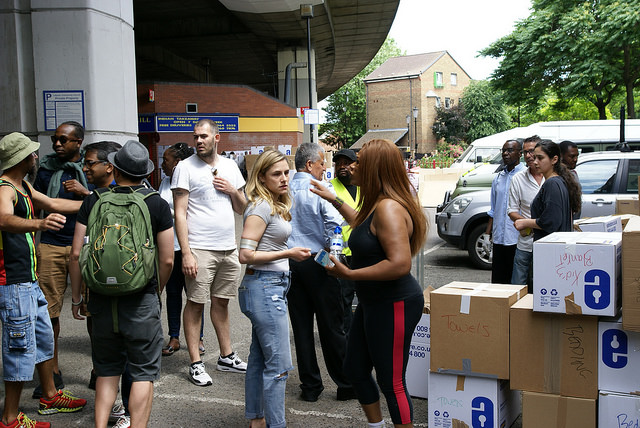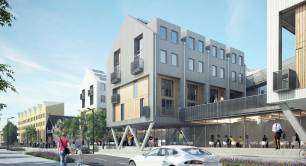Post Grenfell, communities are holding things together
Community organsiations have proved their worth recently, writes Locality CEO Tony Armstrong. Now government and funders need to respond.
Over the last few months we’ve had far too many unexpected shocks and tragic loss of life – the terror attacks in Westminster, Manchester, London Bridge, Finsbury Park, and then the Grenfell Tower fire.
These events were utterly devastating. But through it all, one thing is obvious – when tested, the power of community prevails.
In every situation, communities across the country have responded with staunch defiance and public acts of togetherness: the One Love Manchester concert, the #greatgettogether celebrations marking the anniversary of the murder of Jo Cox, the hundreds who gathered to lay flowers in Finsbury Park.
This has been no more obvious than following the Grenfell Tower fire in west London, a tragedy which has felt painfully familiar but which has also suggested something new.

Above: volunteers for Grenfell (image: ChiralJon)
We have seen the same massive mobilisation of volunteers, the same overwhelming generosity of donations, the same staunch deployment of community resources, and the incredible bravery and determination of the emergency services. But two things feel different.
The first is the sense that the community has been stepping up in a vacuum. Kensington and Chelsea council has faced huge criticism for the paucity of its reaction and has been relieved of responsibility.
Meanwhile the new government, still in flux following the surprise general election result, has been slow to provide clear leadership, with Theresa May admitting initial support for families was “not good enough”.
The second is that while we know we live with growing inequality in our society, we have never before seen it so starkly, and nor with such deadly consequences. One of the most painful aspects of the tragedy is that it would have been entirely preventable if one of the richest boroughs in the country had listened to its poorest residents.
While the media attention dies down and we absorb the lessons around fire safety, deregulation and privatisation to ensure that such a monumental tragedy is never allowed to happen again, we should celebrate the amazing spirit and resilience of the north Kensington community.
Within hours, hundreds of people started donating food, clothing and money from as far away as Birmingham. Without a second thought, people came together. A reminder that the resilience of local communities is a vital part of the fabric which binds us together and is our safety net when we need it.
The response was incredible. And we can learn from the conditions that enabled local people to respond in such an inspiring way and give hope and support in the immediate aftermath of a crisis.
They stepped in because that is what community organisations do
Community organisation Westway Trust has been one of the organisations at the centre of relief, support, and crisis management as a result of the Grenfell Tower tragedy.
Westway Trust came into being due to an asset transfer of its premises to the trust in the 1990s. Since then, it has used its assets to provide services to local people, develop community cohesion and play a leading role in regenerating the local area.
Recently it has been providing shelter and support to the hundreds of individuals and families who have been displaced in the most terrifying of circumstances.
Organisations like Westway Trust are not funded to do this, and nobody in charge initially asked them to do this. They stepped in because that is what community organisations do, in countless situations, ranging from fires, floods, riots, killings and more. These local organisations are the backbone of strong resilient communities.
We saw the same thing on Boxing Day 2015, when Hebden Bridge Town Hall became the town’s flood support centre, coordinating thousands of volunteers to provide emergency assistance.
As the director of Hebden Bridge Community Association explained: “We opened the doors to the Town Hall on 27 December so that the local community could come somewhere dry and have a hot drink. And then it began. People came to help. The help was unconditional; they just needed to do something.
“Within four hours of opening we were a hub for cleaning items, a food bank, a place for people to fill out grant applications, a mobile phone charging point, free WiFi provider and giving out free hot food and drinks.”
Community assets provide resilience – we know from our own research that community organisations owning assets are more stable and resilient than those without. But the human impact of community buildings – sites where a community can come together and forge a way forward in a time of crisis - has rarely been seen so strongly as in the last month.
So now more than ever, we need to invest in our communities and the local community organisations that support them.
At Locality we think there are big opportunities for government, local authorities and funders to come together to do just that: through greater community ownership of assets; continued devolution of power; a fair deal for local organisations involved in public services; and more housing owned or managed by community groups.
We can’t just take the work of communities for granted. Local people, groups and organisations need to be listened to and have more power over what happens in their local area. And they need decent funding to continue to provide valuable services, and run important local facilities and buildings.
We need to do everything in our power to ensure that our community infrastructure is as strong as possible – to strengthen local people’s voices to help prevent such tragedies happening in the first place; and ensure that when they do, we have strong community organisations to lead the response.
Photo credit: ChiralJon



